What Makes Lavash Unique?
We may receive a commission on purchases made from links.
Burgers, kebabs, and pizza — so many of the world's most iconic foods are doughy delights. Humans first created bread 12,000 years ago by combining pulverized grains with water. Before airy loaves dominated the shelves, flatbread was the original, reports Britannica.
Thin dough likely comes from Mesopotamia, concocted with a mix of wild wheat and barley. Since its creation, flatbread has never lost popularity. Wide varieties continue to be consumed around the world — from Indian roti and Chinese jianbing to Mexican tortillas, per SBS. A perfect vehicle for wraps or accompaniment to a stew, the cracker-thin bread is eaten in diverse ways. Such a range of consumption is doubly applicable to lavash, a labor-intensive variety of Armenian flatbread. Integral to Armenian culture, lavash is folded over food, used as a spoon, or simply served as a side. Cooked in a clay oven called a tonir and torn only by hand, this delectable large bread boasts many unique attributes (via TasteAtlas). Let's dive into what makes it so special.
What is lavash?
Made from only wheat flour, salt, water, and sometimes oil, lavash is prepared around the Caucasus, Iran, and Afghanistan. Often rolled into extraordinarily thin layers, some varieties are even near transparent (via Oxford Companion to Food). The food is interlinked with Armenia; in 2014, the bread was inscribed on the UNESCO List of Intangible Cultural Heritage for the Caucasus nation, per UNESCO. Usually prepared by groups of women, the bread-making process involves deftness in dough-making, kneading, and baking. Cooked in a distinct slapping motion inside tonir ovens, the heritage of the bread represents both the culinary product and the associated traditions.
Lavash loaves are large, reaching 35 inches long by 15 inches wide, while only 1/16th of an inch thick. After baking, the bread is hung on wires to dry and stored for up to a year. Once ready for consumption, it's sprayed with water to rehydrate, reports 196Flavors.
History of lavash
Lavash's long history evinces the significance of wheat in the Caucasus region. Consumed for more than 3,000 years, lavash is typically baked during the harvest season, notes Organic Lavash Bread. The yield and storage of grain, mainly wheat and barley, aligned with celebrations. Ears of wheat symbolized eternal life, and the bread-making process garnered significant respect. Baking lavash was traditionally accompanied by special songs and chants, and during holiday periods, production was constant. Always prepped by a group of women, lavash was given to soldiers for protection, and the first lavash of the day was given to the sick. Bread is so integral to the mountainous nation it's even how Armenians say chow down — "let's eat bread," reports Armenian Geographic.
There wouldn't be lavash without the tonir — the large clay oven once the central heating in Armenian homes. Containing coals on the bottom and hot stones on the side, the tonir is now often housed in a separate building called a hatsatun, translated as a bread-house. While also used for roasting and boiling, the oven's most popular creation is always lavash, says Art-A-Tsolum. Let's dive into how the thin bread is made.
How lavash is prepared
Lavash starts from wheat dough, prepared with only water and salt mixed to an ideal consistency. First, it's worked into a ball, which is then rolled into thin layers and stretched over oval molds. Skilled bakers, always women, then slap it into the interior wall of a tonir, an underground oven. After 30 seconds to a minute, the bread is finished. Sometimes it's eaten while still malleable, and other times in a dried cracker form, according to Armenia Discovery.
The less time lavash dough spends over a heat source, the more pliable it becomes — a difficult characteristic to replicate in a home kitchen. Epicurious offers an alternative by preparing lavash on an overturned wok. The curved pan's carbon material enables excellent temperature control, especially with a gas burner. By utilizing a yeasty dough that stores well in the fridge, a fresh lavash can be prepped in a matter of minutes for a quick lunch.
How lavash is eaten
Most famously consumed as a wrap in the U.S., lavash can be used in a wide range of applications. In Armenia, it's commonly wrapped as well, however, as a snack rather than a full lunch. The lavash is rolled around fresh cheese, sprinkled with herbs, and devoured on the go, says Wild Armenia.
Armenians also cover kebabs and other barbecued meats with lavash to absorb all of their delectable juices. Dried lavash is crumbled into soups as a textural component or dipped into broths like khash, which is made from cow hooves, explains Vov World.
When making lavash at home, consider using either variant — soft or crunchy, for applications. Serve lavash crackers, sprinkled with sesame or sumac, alongside spreads like hummus or baba ganoush. Lavash can replace tortillas in quesadillas or even be used as a pizza dough, reports MasterClass. The sky's the limit with this ancient, diverse flatbread — there's nothing else quite like it.




